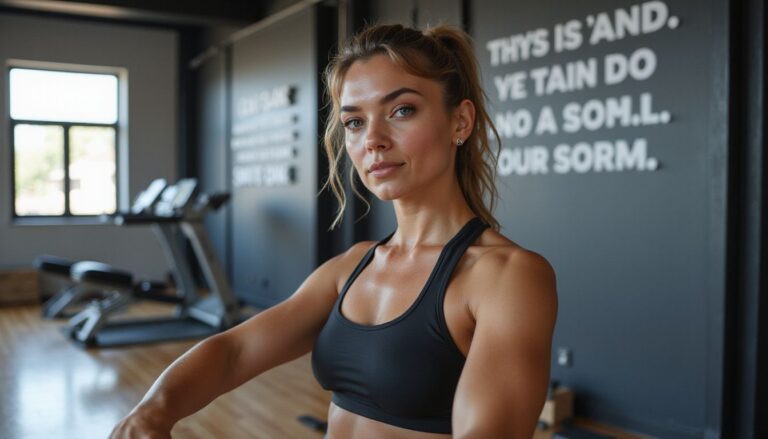Effective Ways To Lower Body Fat: Burn Belly Fat And Achieve Your Weight Loss Goals
Our Nutrition Assistant AI Suite will transform your body. You will lose fat, get toned, and build muscle. Gain confidence and optimal health.
Struggling to lower body fat or lose belly fat is common, even with steady diet and exercise. Too much visceral fat, the deeper type that surrounds your organs, raises the risk of heart disease and type 2 diabetes. This guide shares practical, evidence-based steps that help you reduce body fat percentage with smart eating, effective workouts, and simple daily habits.
Use these steps to build momentum and live a healthier life, one choice at a time.
Key Takeaways
- In The New England Journal of Medicine (2021), losing 5 to 10 percent of body fat reduced heart risk markers and improved metabolic health.
- High-protein meals, a Mediterranean-style pattern, and adding about 14 grams of fiber per day can help reduce total and visceral fat and limit weight regain.
- Cardio for 150 to 300 minutes per week, strength training, and HIIT improve body composition, trim belly fat, and protect muscle, which supports your basal metabolic rate.
- Getting 7 to 9 hours of sleep and managing stress can steady hunger hormones and decrease visceral fat around organs.
- Tracking with body fat scales, waist measurements, and simple food logs keeps motivation up and supports long-term fat loss habits.

Understanding Body Fat

Body fat stores energy and cushions organs. It is useful in healthy amounts, yet too much can raise the risk of obesity and heart problems. Knowing the types of fat helps you set better goals for weight loss and body composition.
What Are the Differences Between Subcutaneous and Visceral Fat?
Subcutaneous fat sits under the skin, often in the thighs, hips, and arms. You can pinch it with your fingers. Visceral fat lies deeper in the abdomen and surrounds the liver, pancreas, and intestines.
Visceral fat is not visible from the outside. High levels are linked with insulin resistance, type 2 diabetes, and cardiovascular disease. People with more visceral fat often have a higher body mass index and more abdominal obesity, even if they look average in weight.
During my own weight loss, the fat near my waist felt firm compared with the softer fat on my legs. Learning the difference helped me target habits that reduce the deeper, riskier type.
Lowering visceral fat through aerobic exercise, resistance training, and balanced meals can improve body composition and reduce disease risk.
Why Is Reducing Body Fat Important for Your Health?
Excess fat, especially visceral fat, crowds your organs and raises disease risk. Higher levels can lead to type 2 diabetes, high blood pressure, heart disease, and certain cancers.
The Centers for Disease Control and Prevention notes that a large waist and higher body fat percentage are linked with metabolic syndrome and fatty liver disease. Extra fat also strains blood vessels, which can harm circulation.
Improving diet quality and moving more can lower cholesterol, stabilize blood sugar, and support heart and lung function. Fast loss is not the goal. A steady approach protects muscle and supports a healthy weight.
A 2021 study in The New England Journal of Medicine found that losing 5 to 10 percent of total body fat lowered several heart risk factors. Strength training helped me trim belly fat while gaining strength, which made daily tasks easier.
Reducing visceral fat helps support organ health and lowers your risk for serious illness, says Dr. Maria Rodriguez, an obesity specialist.
Food choices and eating patterns drive how your body stores or burns fat.
Diet Strategies to Lower Body Fat
Your eating habits can make fat loss faster, easier, and more sustainable. Choose foods that keep you full, protect muscle, and steady blood sugar.
How Does a High Protein Diet Help Burn Fat?
Protein has a high thermic effect, which means your body uses more energy to digest it than carbs or fats. For every 100 calories of protein, about 20 to 30 calories are spent on digestion.
Studies show higher protein intake supports fat loss and helps prevent weight regain. It also reduces hunger, making a calorie deficit easier. Good sources include beans, tofu, fish, eggs, chicken, and Greek yogurt.
Adding protein at every meal supports muscle while you lower your body fat percentage.
What Are Healthy Fats and Why Should You Include Them?
Your body needs healthy fats to absorb vitamins, build cells, and fuel the brain. Olive oil, nuts, seeds, avocados, and salmon provide monounsaturated and polyunsaturated fats.
These fats can reduce visceral fat and improve body composition. A Mediterranean-style diet rich in healthy fats helps many adults lose extra fat and support heart health.
Swap butter for olive oil and add a small handful of nuts to snacks or salads. This simple shift can increase fullness and aid sustainable fat loss.
“Replacing saturated fats with unsaturated fats may reduce the risk of heart disease and aid weight management.”
How Can Fiber Help You Feel Full and Lose Fat?
Fiber and healthy fats work well together. Fiber helps you feel full on fewer calories and improves body composition over time.
Soluble fiber absorbs water in the gut and forms a gel, which slows stomach emptying. Oatmeal or lentils at breakfast often keep you satisfied longer than white bread. Whole grains, fruits, vegetables, legumes, and nuts add fiber plus key vitamins and minerals.
In one study, adults who increased fiber by 14 grams per day lost about 4 pounds in four months without other changes. Fiber also reduces blood sugar spikes from refined carbs and can lower waist size. In my routine, starting the day with whole grain toast cut late-morning cravings.
Source: American Journal of Clinical Nutrition, 2015
Why Should You Limit Added Sugars and Refined Carbs?
Diets high in added sugars and refined carbs are linked with more total fat and more abdominal fat. Cakes, candy, soda, and pastries add calories without fiber or key nutrients.
Replacing refined carbs with whole grains, beans, and fruit improves body composition and helps preserve muscle during weight loss. Cutting back on sugar also steadies energy and appetite.
What Are the Benefits of Drinking Unsweetened Beverages?
Unsweetened drinks help you reduce calories without losing nutrition. Research finds that swapping sugar-sweetened beverages for water or zero-calorie options can reduce body fat by about 1 to 2 percent over a few months.
Water, herbal tea, and black coffee do not spike insulin the way sugary drinks can. I switched to unsweetened iced green tea and felt less bloated and more hydrated during the day.
Exercise Techniques for Fat Loss
Exercise helps burn calories, build muscle, and improve your basal metabolic rate. Think of movement as your daily nudge toward better body composition.
How Can Cardio Workouts Help You Lose Fat?
Cardio raises heart rate and uses stored energy from adipose tissue. Brisk walking, cycling, and swimming are great options for most fitness levels.
Studies suggest 150 to 300 minutes of moderate cardio per week can lower body fat percentage. High-intensity interval training, or HIIT, can target belly fat and improve fitness in less time.
Alternating short sprints with easy recovery periods challenges your circulatory system and may help reduce the fat that surrounds organs. Many people notice their clothes fit better before the scale changes much.
Why Is Strength Training Important for Fat Loss?
Strength training builds skeletal muscle, which burns more calories at rest. As muscle increases, body composition improves and body mass index often drops.
Studies show people who lift weights while dieting lose more fat than those who do cardio alone. Weight training also supports hormones that aid fat loss. When I added weights, my clothes fit better and weekly strength gains kept me motivated.
What Is High-Intensity Interval Training (HIIT) and How Does It Work?
HIIT pairs short bursts of hard effort with rest or easy movement. For example, sprint for 30 seconds, then walk for 60 to 120 seconds, and repeat.
This method boosts calorie burn and can improve artery health. Many people prefer HIIT because sessions are brief, intense, and require little or no equipment. The afterburn effect, which is extra calorie burn after exercise, can add a small bonus.
How Can You Add More Movement to Your Daily Routine?
Small actions done often help you burn more calories and support fat loss. Use daily tasks as chances to move more.
- Walk or bike short trips under a mile to increase step count and use large muscle groups.
- Choose stairs whenever possible to raise heart rate and strengthen your legs.
- Stand and stretch every 30 to 60 minutes if you sit for work to improve circulation.
- Do squats, wall push-ups, or calf raises during TV breaks or while waiting in the kitchen.
- Use a standing desk, or switch between sitting and standing to keep blood flowing.
- Take phone calls while walking to add easy steps to your day.
- Play active games with kids or pets for movement that feels fun, not formal.
- Park farther away and walk briskly to the entrance for extra daily steps.
- Cook more often. Chopping, stirring, and moving around the kitchen beats sitting.
- Stretch in the morning and before bed to support healthy joints as you lose weight.
I started parking farther from work and felt more energized within two weeks. Small shifts added up to a more active day and better progress.
Lifestyle Changes to Support Fat Loss
Simple lifestyle changes, like better sleep, stress control, and whole foods, strengthen your plan. These choices make it easier to burn fat effectively.
How Much Sleep Do You Need to Support Fat Loss?
Aim for 7 to 9 hours of sleep per night. Sleeping less than 6 hours is linked with more belly fat and stronger food cravings.
Sleep helps regulate leptin and ghrelin, the hormones that affect hunger and fullness. A regular sleep schedule, less screen time before bed, and avoiding late caffeine can improve both rest and fat loss.
What Are Effective Ways to Manage Stress?
Stress can raise cortisol, a hormone tied to belly fat. Lower stress to support your body’s ability to burn fat and maintain a healthy diet.
- Practice deep breathing daily to slow heart rate and lower cortisol.
- Schedule brief activity breaks. Even a short walk can relieve stress.
- Limit ads for fast food if they trigger cravings during busy days.
- Keep healthy snacks handy. Nuts provide vitamin E and satisfying fats.
- Practice mindful eating. Slow down and notice flavors to avoid emotional eating.
- Connect with friends or support groups to improve mood and accountability.
- Use simple planning tools. Meal plans and steady bedtimes reduce stress.
- Try gentle stretching or calming music to relax at the end of the day.
During a hectic week of work and studying, deep breathing helped me avoid stress snacking and stay on track with my plan.
Managing stress supports your organs and reduces the harmful fat that surrounds them.
Why Should You Avoid Processed and Fast Foods?
Processed and fast foods are often high in added sugar, unhealthy fats, and salt. They add many calories with little fiber or nutrition.
Research links these foods to more visceral fat and higher risk of type 2 diabetes and heart disease. Choose fruits, vegetables, nuts, and lean proteins instead. Cooking simple meals based on a Mediterranean pattern helped me boost energy and drop body fat within a few months.
How Does Mindful Eating Aid in Losing Body Fat?
Mindful eating means you focus on hunger, fullness, and the experience of eating. It can cut overeating by about 20 percent per meal in some studies.
Listening to your body leads to better portion control and improved food quality. People who struggle with emotional eating often find this approach helps reduce visceral fat over time.
Science-Backed Methods to Burn Belly Fat
Your body can learn to use stored fat more efficiently with a few proven methods. Think of these tools as levers you can pull when progress slows.
What Is Intermittent Fasting and How Does It Help?
Intermittent fasting cycles between eating and fasting windows, such as 16 hours of fasting and 8 hours for meals. This pattern can lower calorie intake and help your body draw energy from stored fat.
Reviews suggest it may reduce visceral fat in some adults. Many people feel less hungry after the first week. Drinking water, coffee, or unsweetened tea during fasting hours can make it easier to stick with the plan.
During meals, focus on Mediterranean-style foods like vegetables, beans, whole grains, nuts, and olive oil to support steady energy and fat loss.
How Can Probiotics Support Fat Loss?
Probiotics are helpful bacteria that support gut balance and digestion. Certain strains may assist fat loss by improving how your body processes food and manages appetite.
In one study, people taking Lactobacillus gasseri lost about 8.5 percent of belly fat over 12 weeks compared with a placebo group. Yogurt and kefir with live cultures are easy ways to add probiotics to your diet.
Why Focus on Whole Foods and Balanced Meals?
Whole foods give you fiber, vitamins, and minerals without extra sugar or unhealthy fats. Build meals around vegetables, fruits, nuts, seeds, eggs, lean meats, beans, and whole grains.
Diets high in ultra-processed items tend to raise body fat. Swapping chips for mixed nuts and fruit helped me feel full and make better choices later in the day.
Plan plates around real ingredients and track your intake briefly each day. This supports consistent progress without feeling deprived.
Measuring and Tracking Progress
Tracking shows what is working so you can adjust with confidence. Small wins add up when you can see them clearly.
How Do You Monitor Your Body Fat Percentage?
Bioelectrical impedance scales estimate fat, muscle, and water using a small current. Skinfold calipers measure fat under the skin at specific points. These tools are estimates, but they are useful for spotting trends.
Also measure your waist and hips with a tape measure to track changes in abdominal fat. Log results monthly to watch progress.
These methods reveal changes that a regular scale might miss.
What Are Non-Scale Victories and Why Do They Matter?
Non-scale victories are signs of progress that have nothing to do with your weight. Examples include climbing stairs with less effort, sleeping better, or seeing more muscle definition.
Doctors and dietitians value these wins because better body composition and organ health matter more than a single number. Muscle can increase while fat drops, so the scale may pause while you improve.
How Can Keeping a Food and Exercise Journal Help You?
Journaling gives you objective feedback about your habits. It can uncover patterns that block fat loss.
- Write down everything you eat and drink, including portions and beverages.
- Note the times you eat and exercise to spot late snacking or missed workouts.
- Track protein, fiber, and healthy fats from foods like nuts and seeds.
- List workout types such as cardio, strength training, or HIIT.
- Record energy, hunger, and mood before and after meals or workouts.
- Review your notes weekly to set one or two clear goals.
- Highlight wins, like hitting step goals or swapping refined carbs for fruit.
Consistent logging builds momentum and keeps you focused on the actions that move the needle.
Benefits of Lowering Body Fat
Carrying less fat supports long-term health and daily energy. Many people feel the difference in both body and mind.
How Does Lower Body Fat Reduce Chronic Disease Risk?
Less fat means less strain on the liver, heart, and pancreas. Visceral fat raises the risk of type 2 diabetes, heart disease, and fatty liver disease.
Losing 5 to 10 percent of body weight can improve blood pressure, cholesterol, and blood sugar. Choosing whole foods, like fruit and nut butters, nourishes the body without extra sugar or unhealthy fats.
What Improvements Can You Expect in Body Composition and Muscle?
Fat loss increases the ratio of muscle to fat. Muscles become more visible and your shape looks firmer.
Strength training helps you keep lean mass while losing fat. Protein-rich foods support muscle repair after workouts, which improves strength and endurance. Many adults see faster body composition changes when they pair resistance training with higher protein.
How Does Losing Body Fat Boost Energy and Well-Being?
As excess fat drops, organs work more efficiently. Less visceral fat means less strain on your heart and liver. People often report higher energy, better focus, and more stable mood.
In my case, replacing processed snacks with a handful of nuts gave me steady afternoon energy without crashes.
Common Myths About Fat Loss
Myths can slow progress and drain motivation. Clear science helps you focus on what works.
Is Spot Reduction Possible or Is Full-Body Fat Loss Needed?
Spot reduction does not work. Doing many sit-ups will not melt belly fat unless you lower total body fat.
Full-body fat loss comes from balanced meals, cardio, strength training, and daily movement. This approach trims the waist, thighs, and arms over time.
Why Are Crash Diets and Quick Fixes Ineffective?
Crash diets often cause quick losses from water and muscle, not fat. Very low calories can slow metabolism, making fat loss harder later.
Many people regain the weight within a year. These plans rarely teach lasting habits or provide enough nutrients for organ health. Choose steady, realistic changes for results that stick.
Frequently Asked Questions
Here are clear answers to common questions so you can set expectations and plan wisely.
How Long Does It Typically Take to Lose Body Fat?
Most people can lose 1 to 2 pounds per week with a calorie deficit of 500 to 1,000 per day. That often equals about 0.5 to 1 percent body fat loss per month.
Track with body fat scales and waist measures for better feedback. Results vary with age, sex, genetics, and starting point. Steady effort brings steady change.
Can You Lose Belly Fat Without Exercising?
Diet alone can reduce belly fat. Cutting calories, increasing fiber, and choosing whole foods such as fruits, vegetables, beans, and nuts can lower abdominal fat.
One study found that higher fiber intake from plants was linked to less belly fat even without added exercise. I once focused on meals after an injury and saw looser clothes and higher energy with simple swaps like protein, vegetables, and nuts.
Sleep, stress control, and unsweetened drinks also make a noticeable difference.
Is It Possible to Maintain Fat Loss Long-Term?
Yes, long-term success comes from consistent habits. Balanced meals with lean protein, whole grains, and healthy fats paired with daily movement help prevent regain.
Keep a simple journal for accountability, aim for enough sleep, and manage stress. Setting small weekly goals keeps you moving forward.
Conclusion
Reaching weight loss goals takes a clear plan and patience. Build meals around protein, fiber, and healthy fats, and use cardio, strength training, and HIIT to protect muscle and reduce belly fat. Sleep well, manage stress, and track your progress to stay focused.
Small daily choices compound into real change. For medical concerns or complex conditions, talk with a healthcare professional for personalized advice. Stay consistent with these evidence-backed steps, and you will see better body composition, lower body fat, and more energy for everyday life.
FAQs
1. What are effective ways to lower body fat and burn belly fat?
Eating a balanced diet, increasing physical activity, and monitoring calorie intake help reduce body fat. Including nut (fruit) in your meals can support weight loss due to its healthy fats and protein content. Studies show that regular exercise combined with dietary changes leads to greater reductions in abdominal fat.
2. How do nuts (fruits) contribute to weight loss goals?
Nut (fruit) provides fiber, protein, and healthy fats that promote fullness and reduce overeating. Research published in the American Journal of Clinical Nutrition found that people who eat nuts regularly tend to have lower body mass indexes compared to those who do not.
3. Are there specific data or nutritional facts about nuts (fruits) that support their role in weight management?
Yes, for example, one ounce of almonds contains about 160 calories, 6 grams of protein, 3 grams of fiber, and 14 grams of healthy fats. These nutrients help control hunger and support metabolism. A table comparing different nuts can show their nutritional value for weight loss.
4. Can you share a personal experience with using nuts (fruits) in a weight loss plan?
Including nut (fruit) as a snack helped me avoid processed foods during my own weight loss journey. I noticed improved satiety and fewer cravings throughout the day. This simple change made it easier to stick to my calorie goals and contributed to steady progress toward my target weight.
Summary: Lowering body fat requires consistent healthy eating habits, regular exercise, and smart food choices like adding nut (fruit). Scientific evidence supports the benefits of these foods in managing hunger and supporting weight loss goals. Personal experiences also highlight the practical advantages of including them in daily routines.







